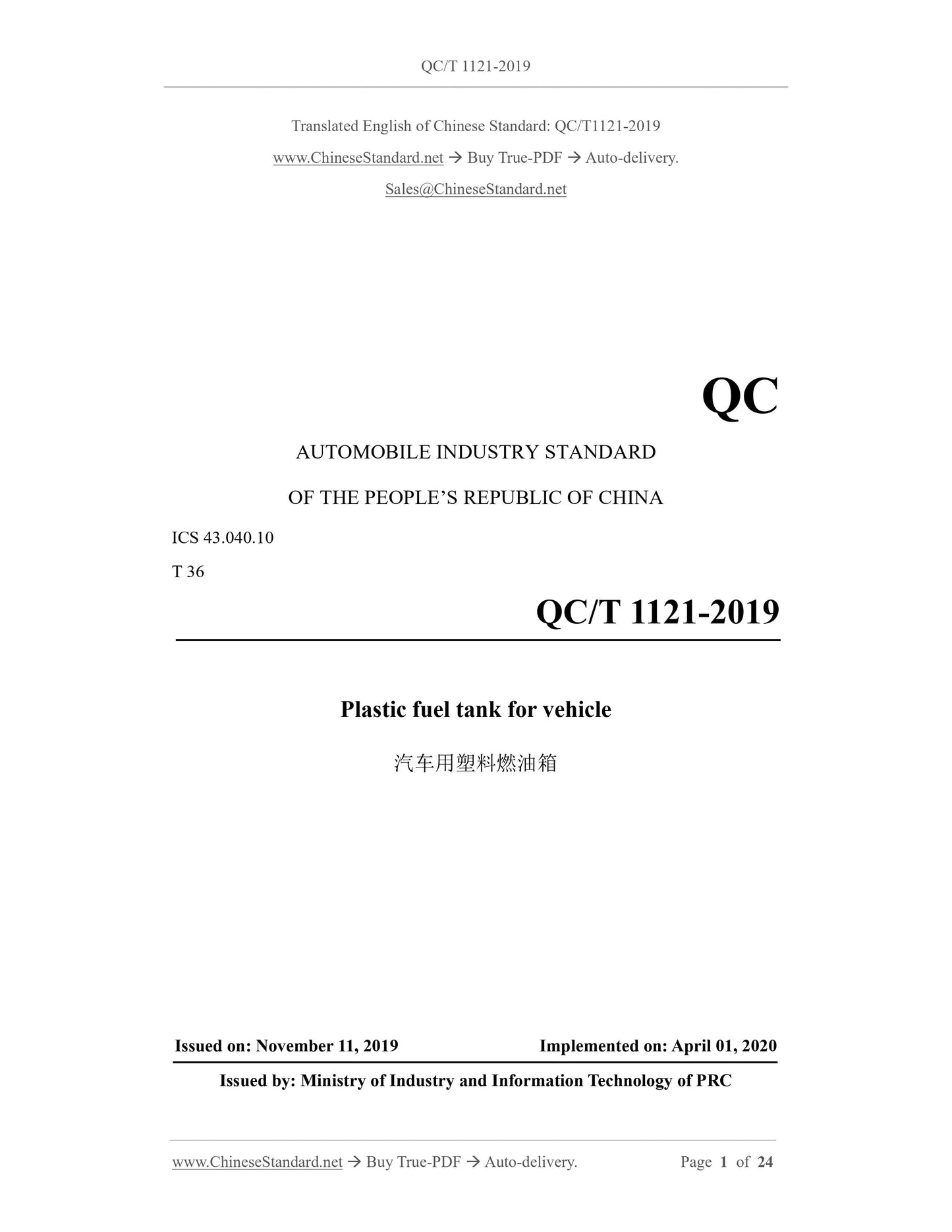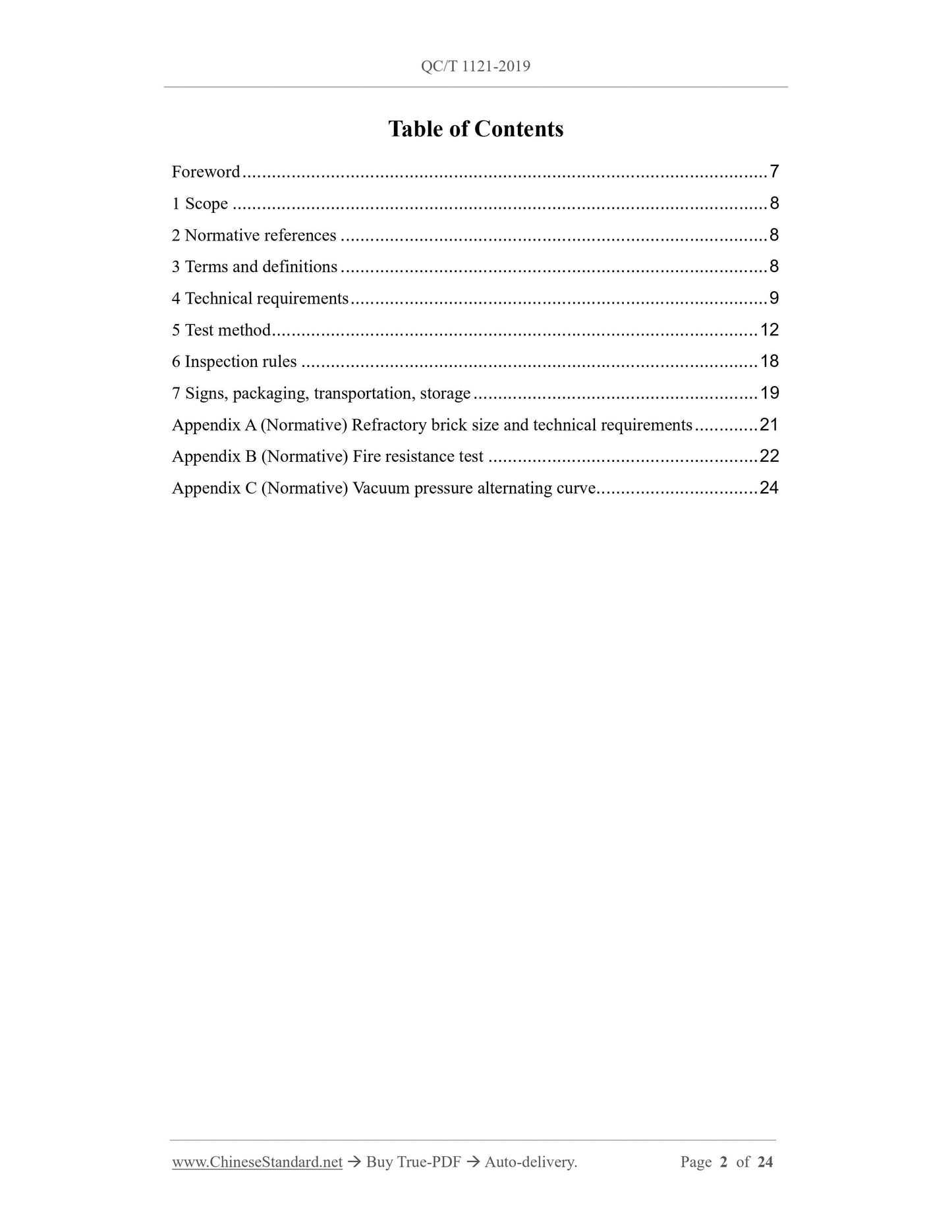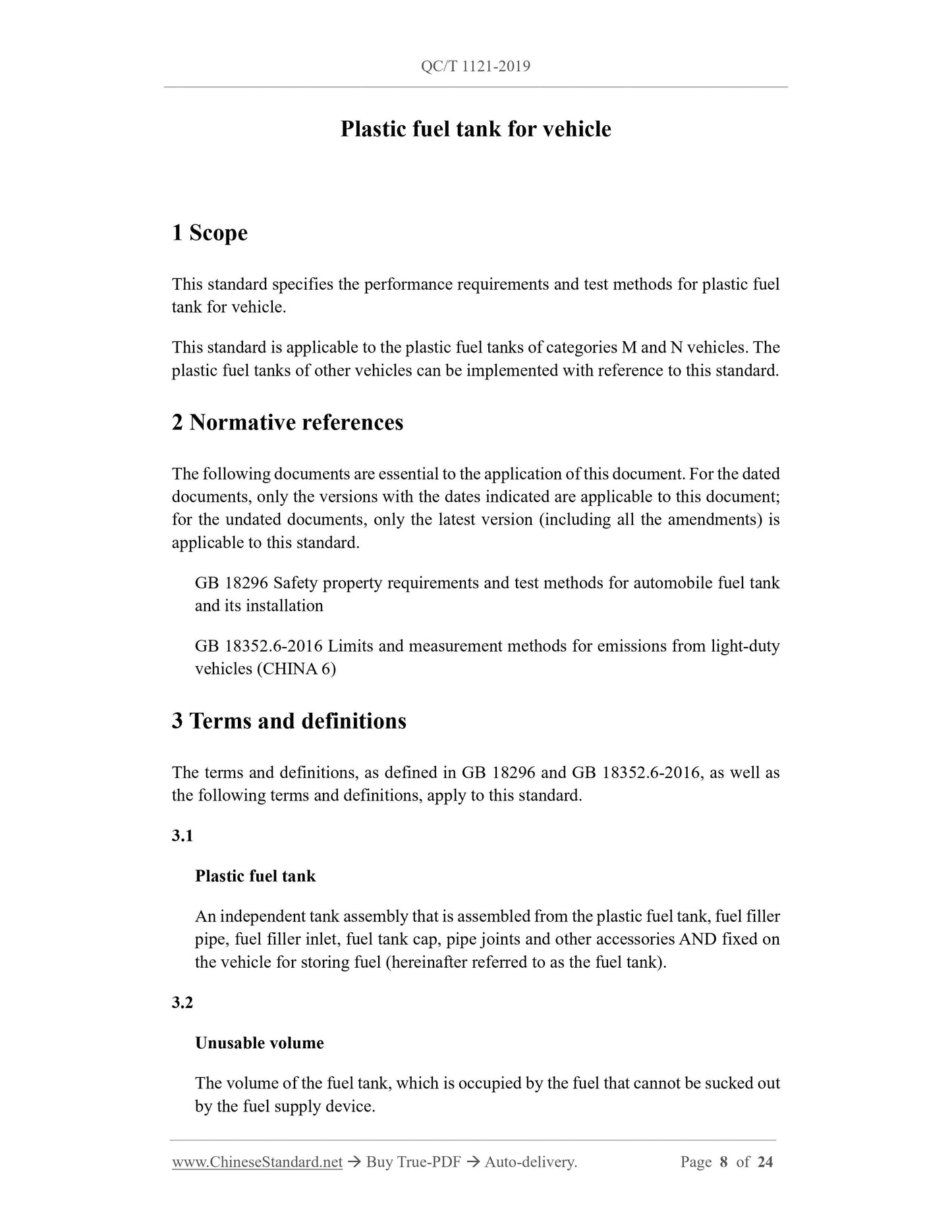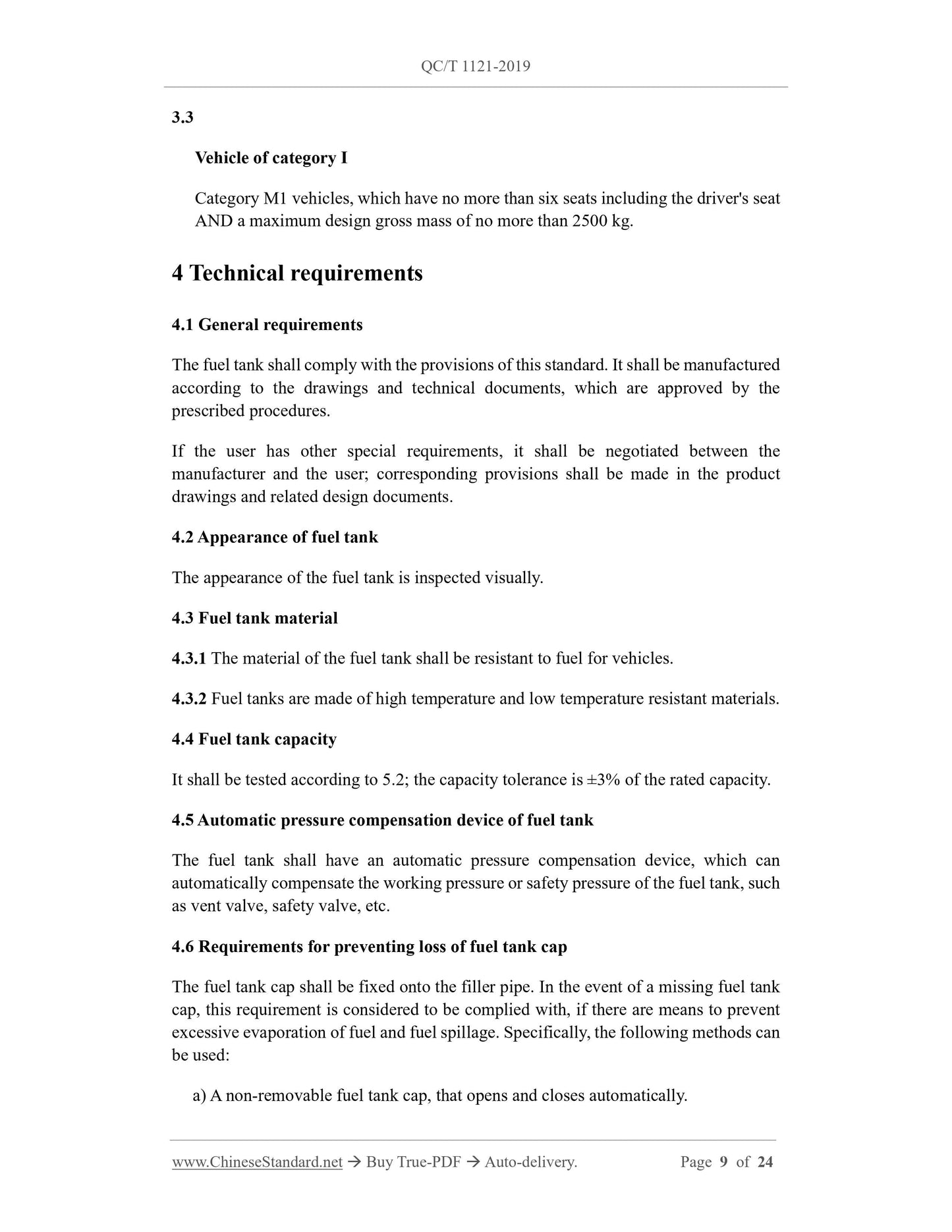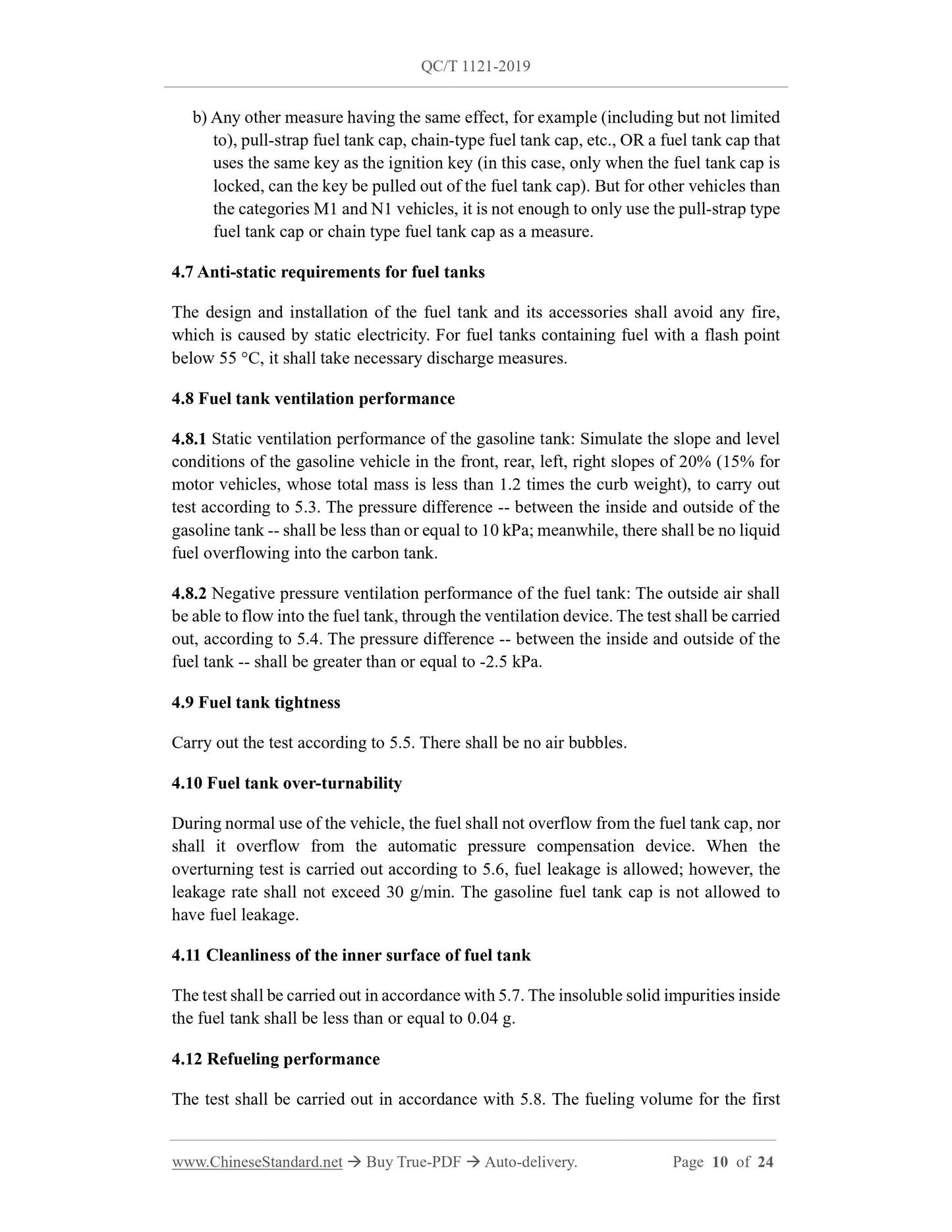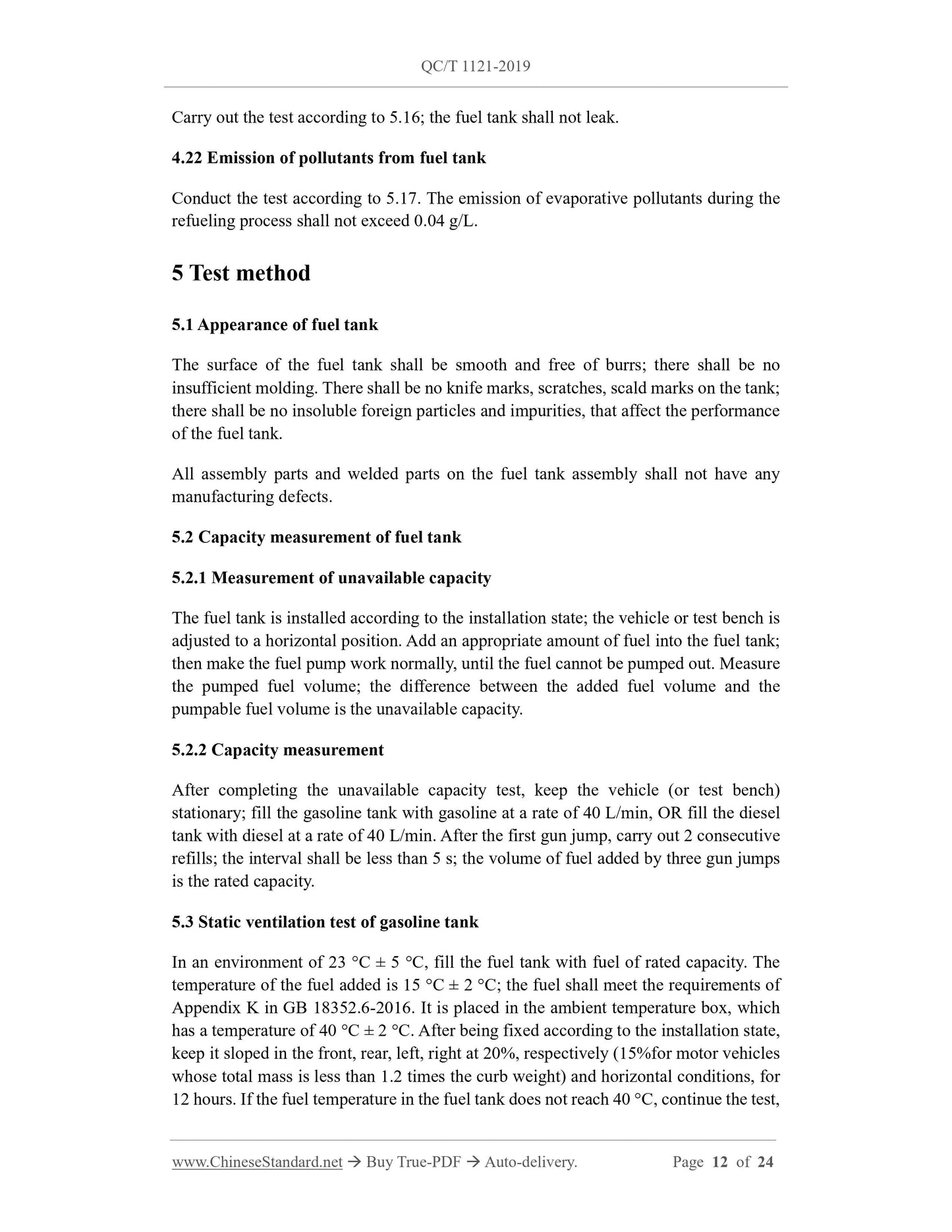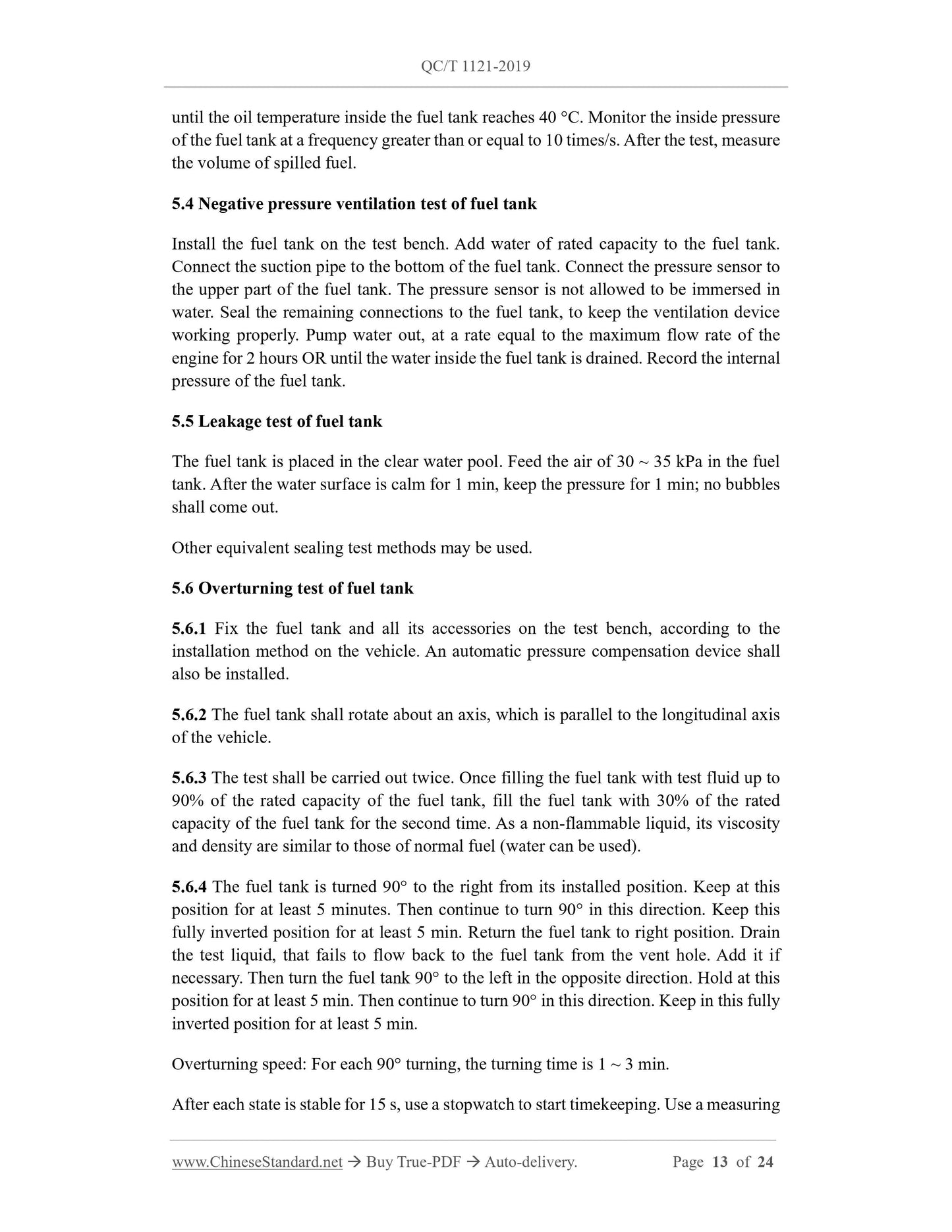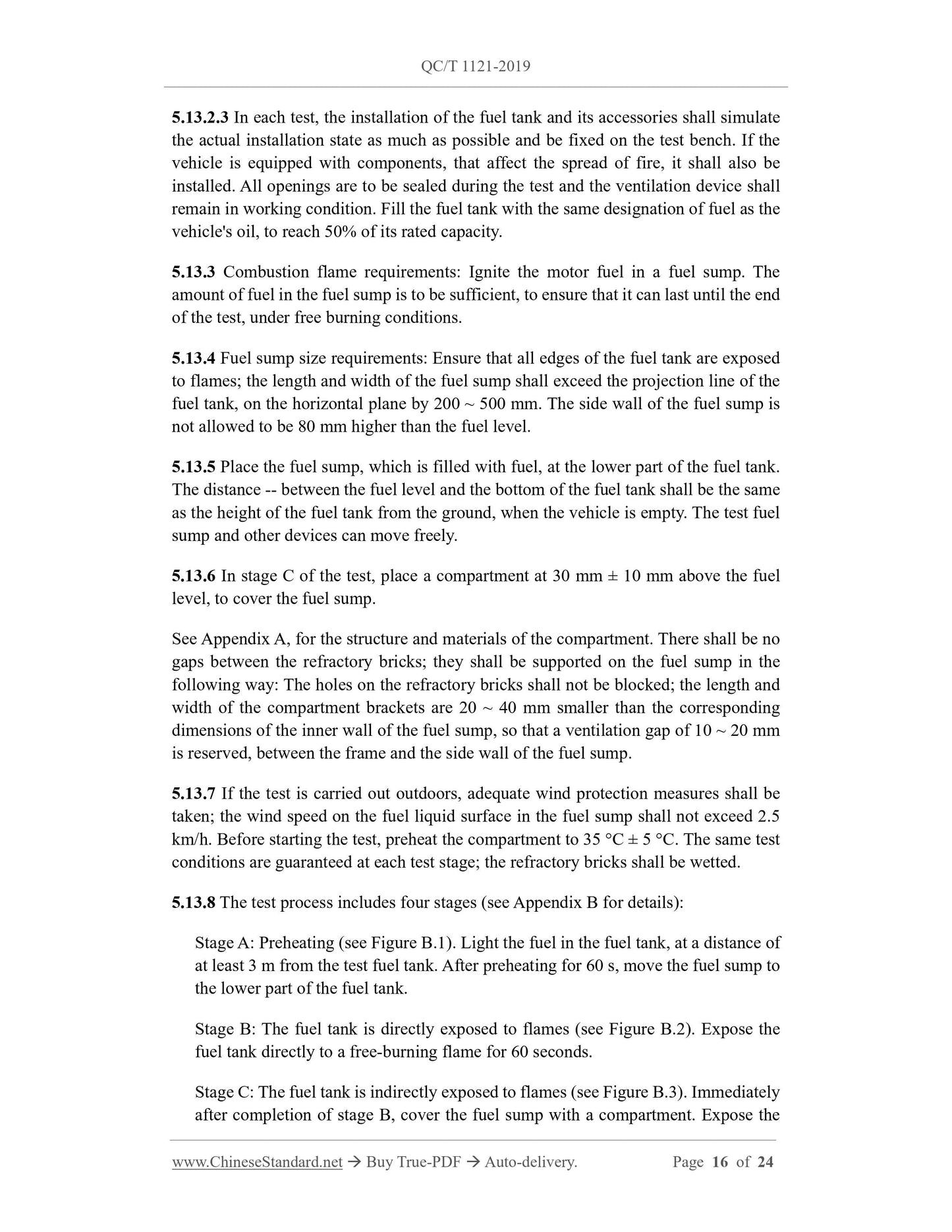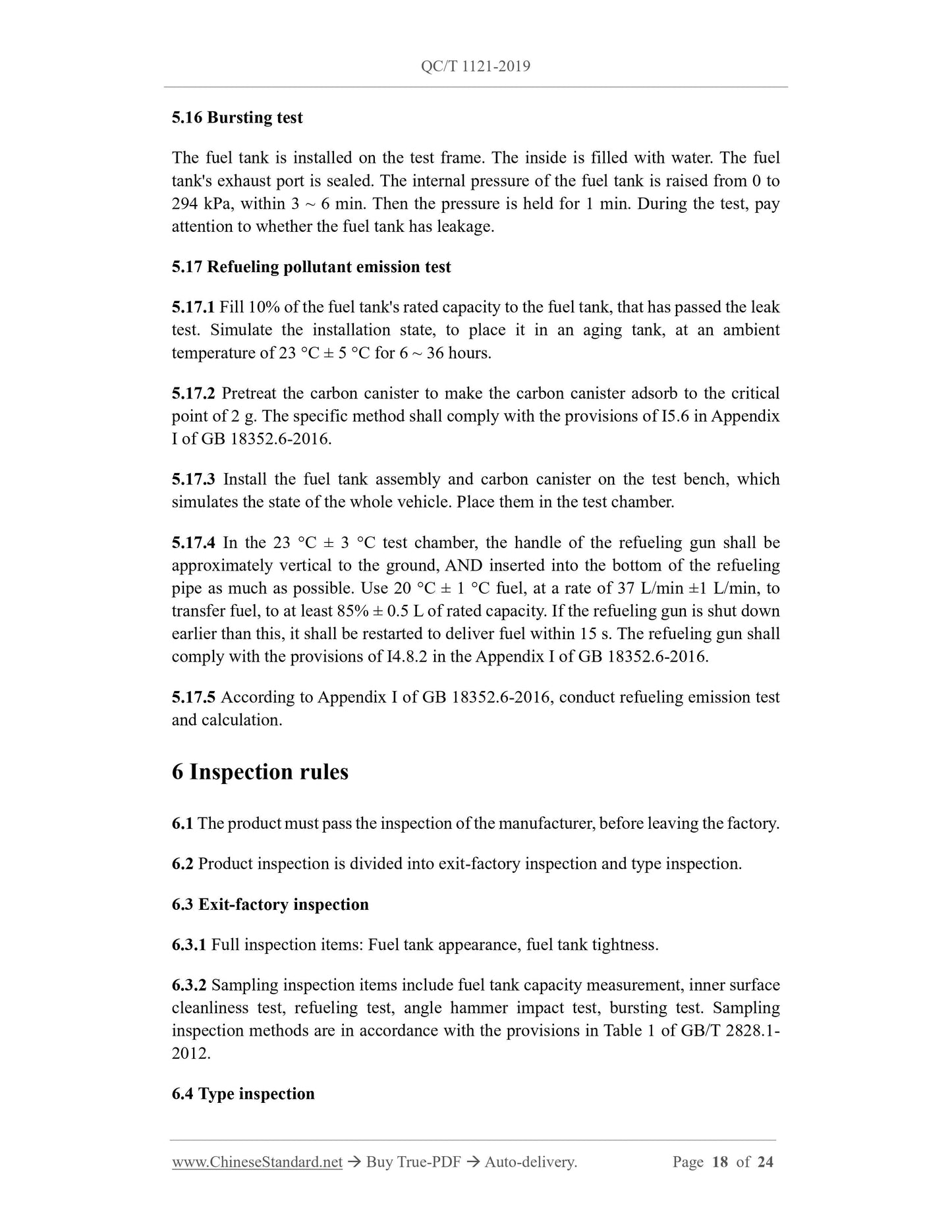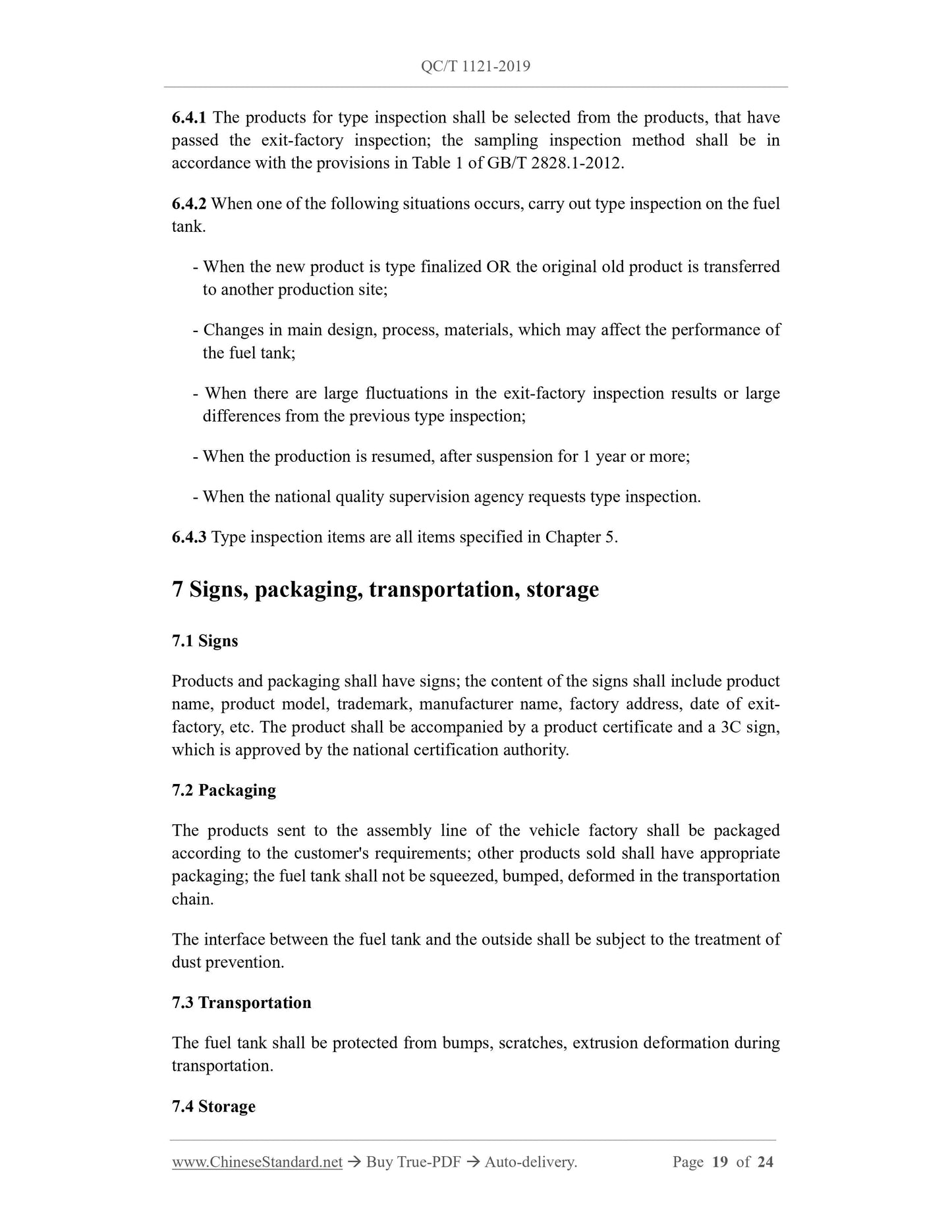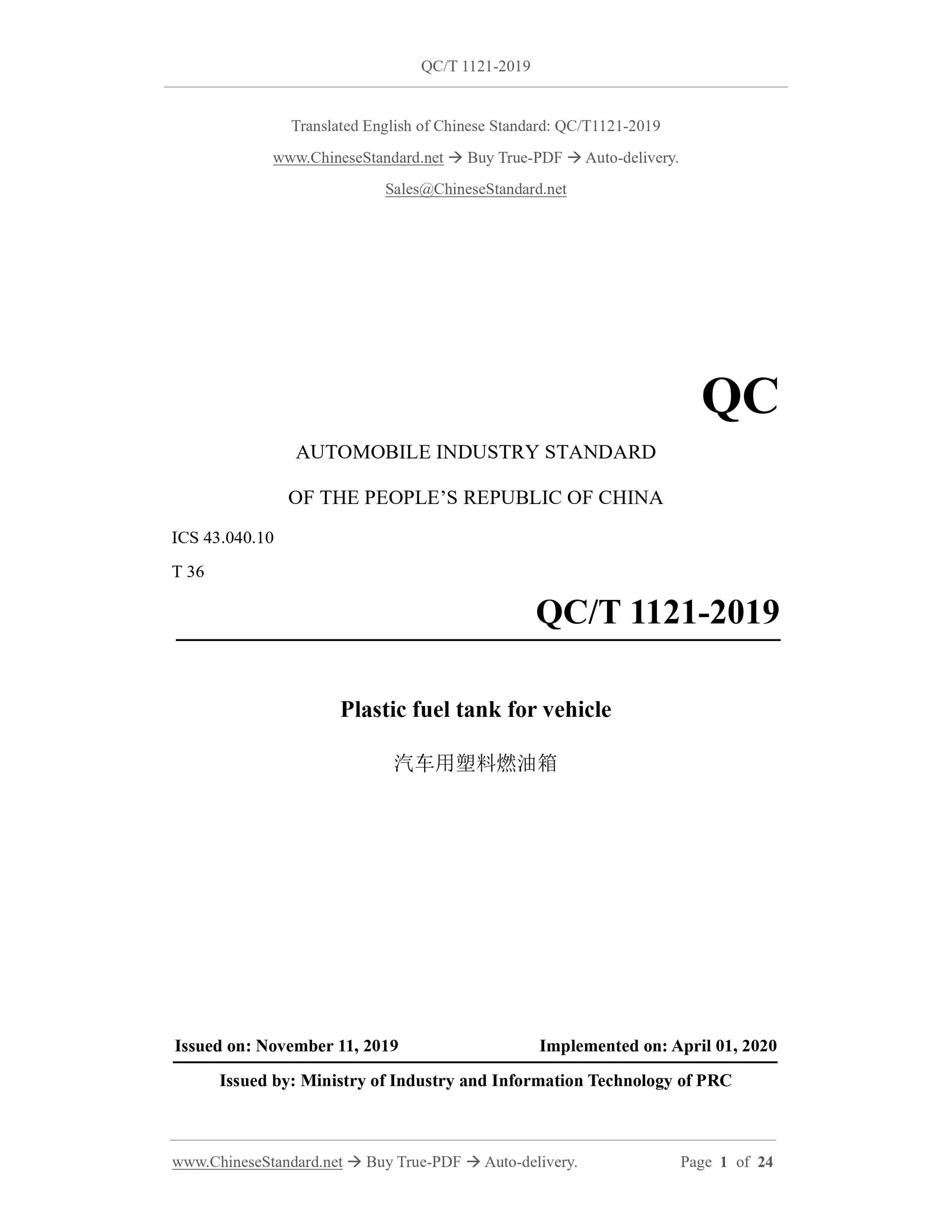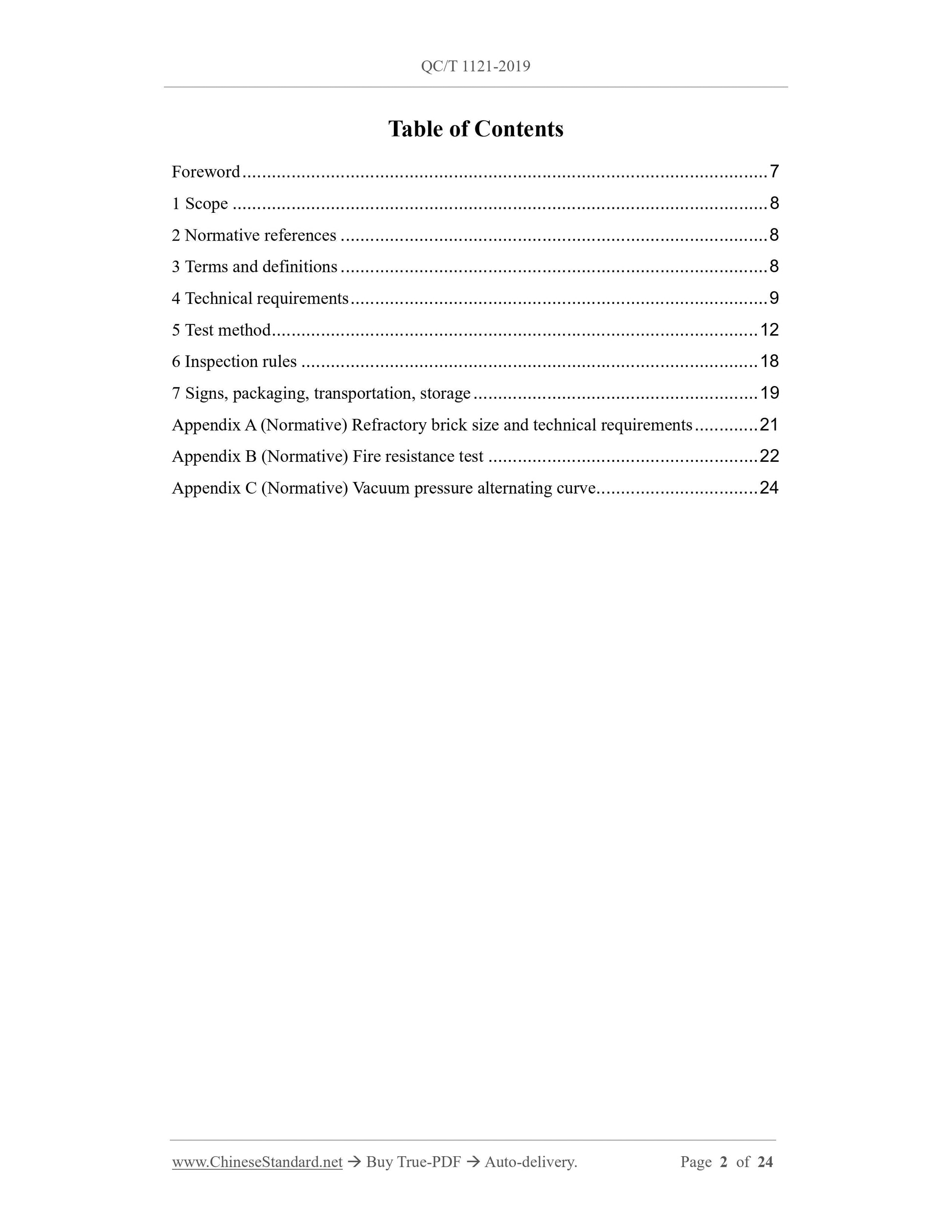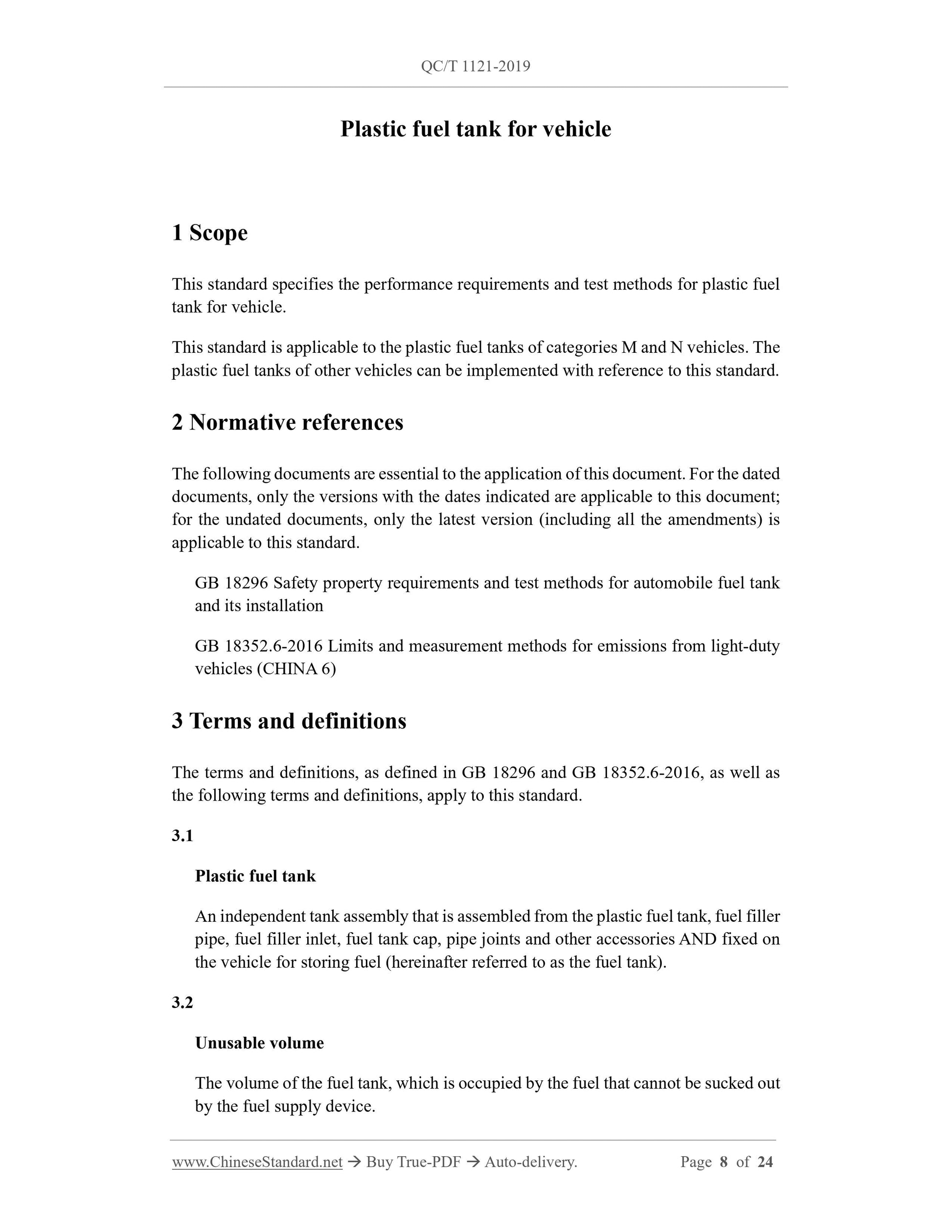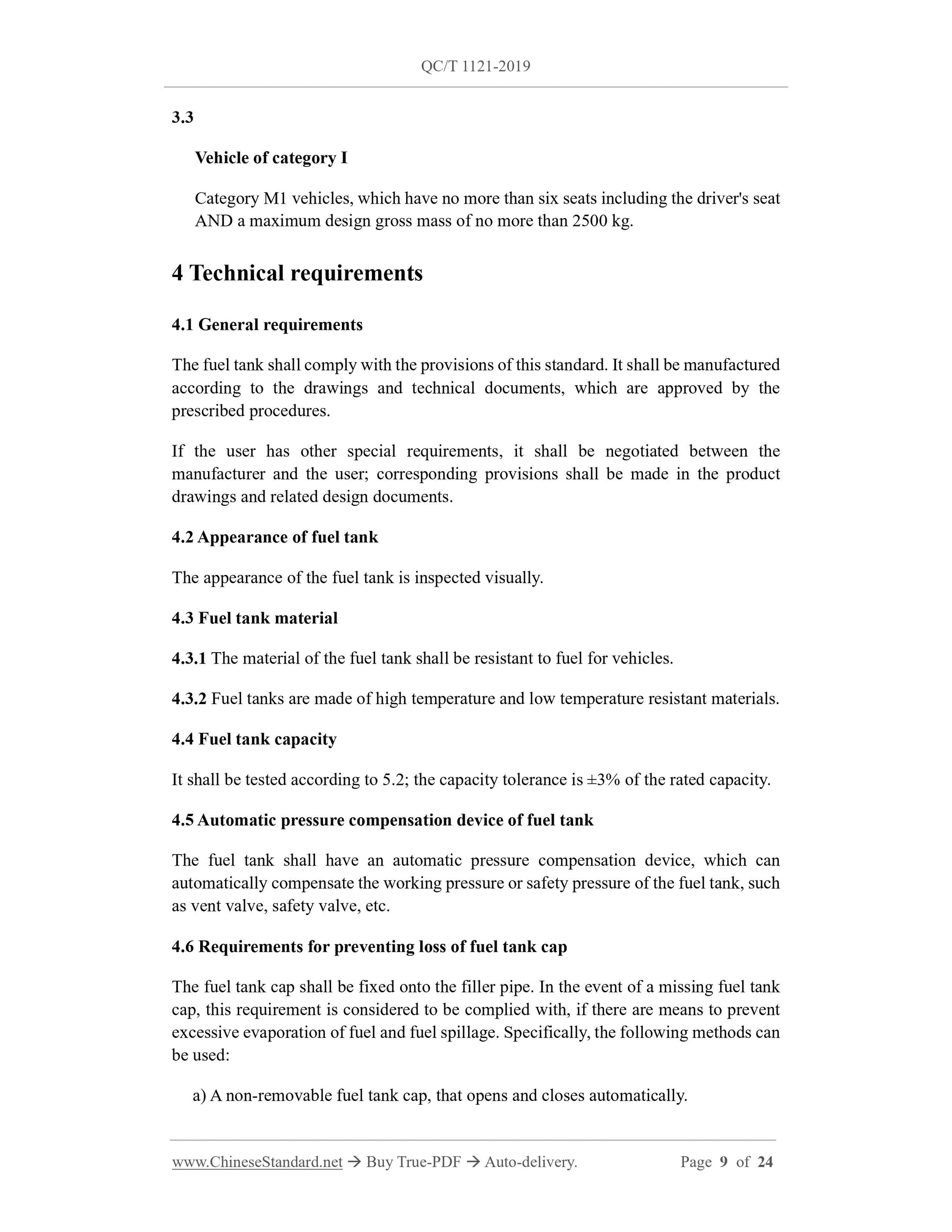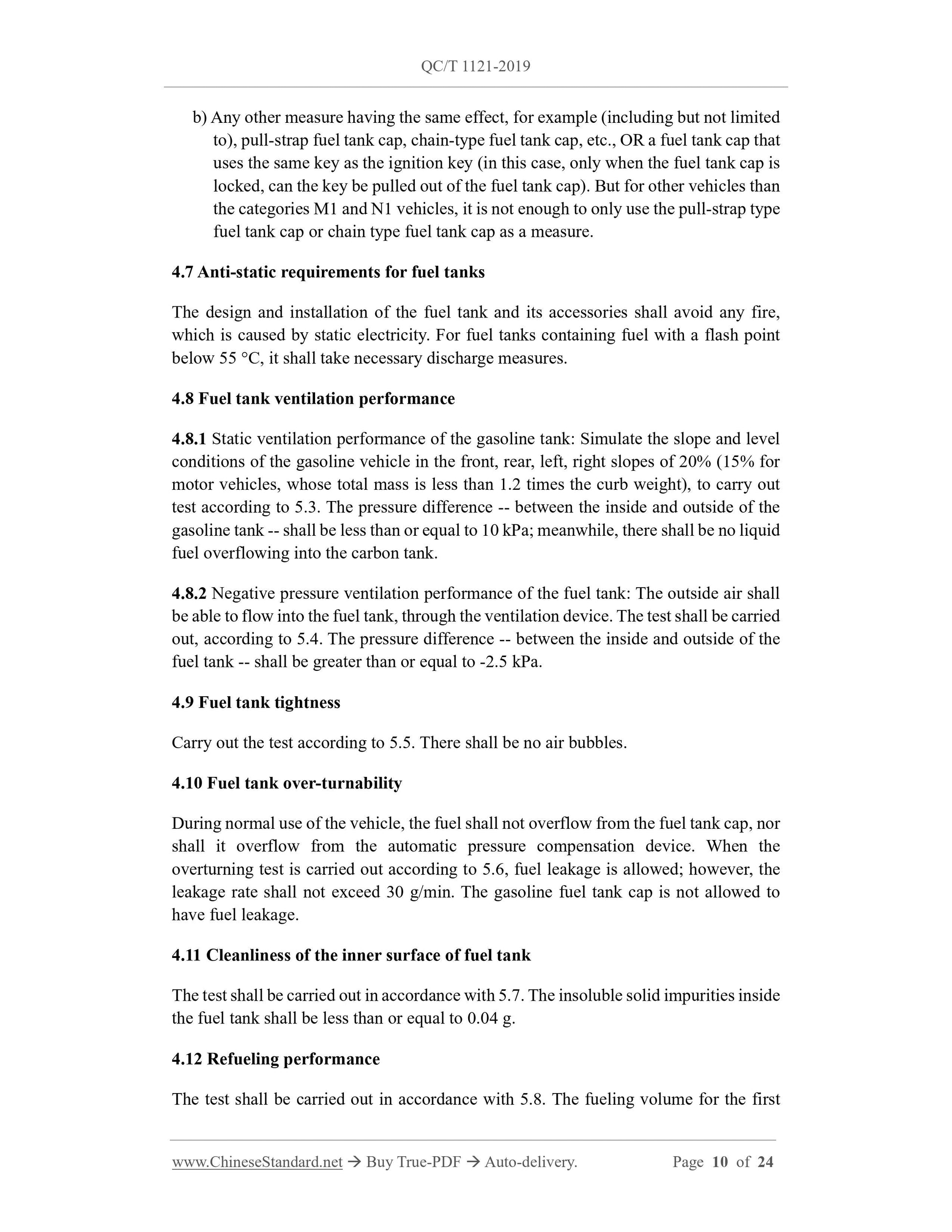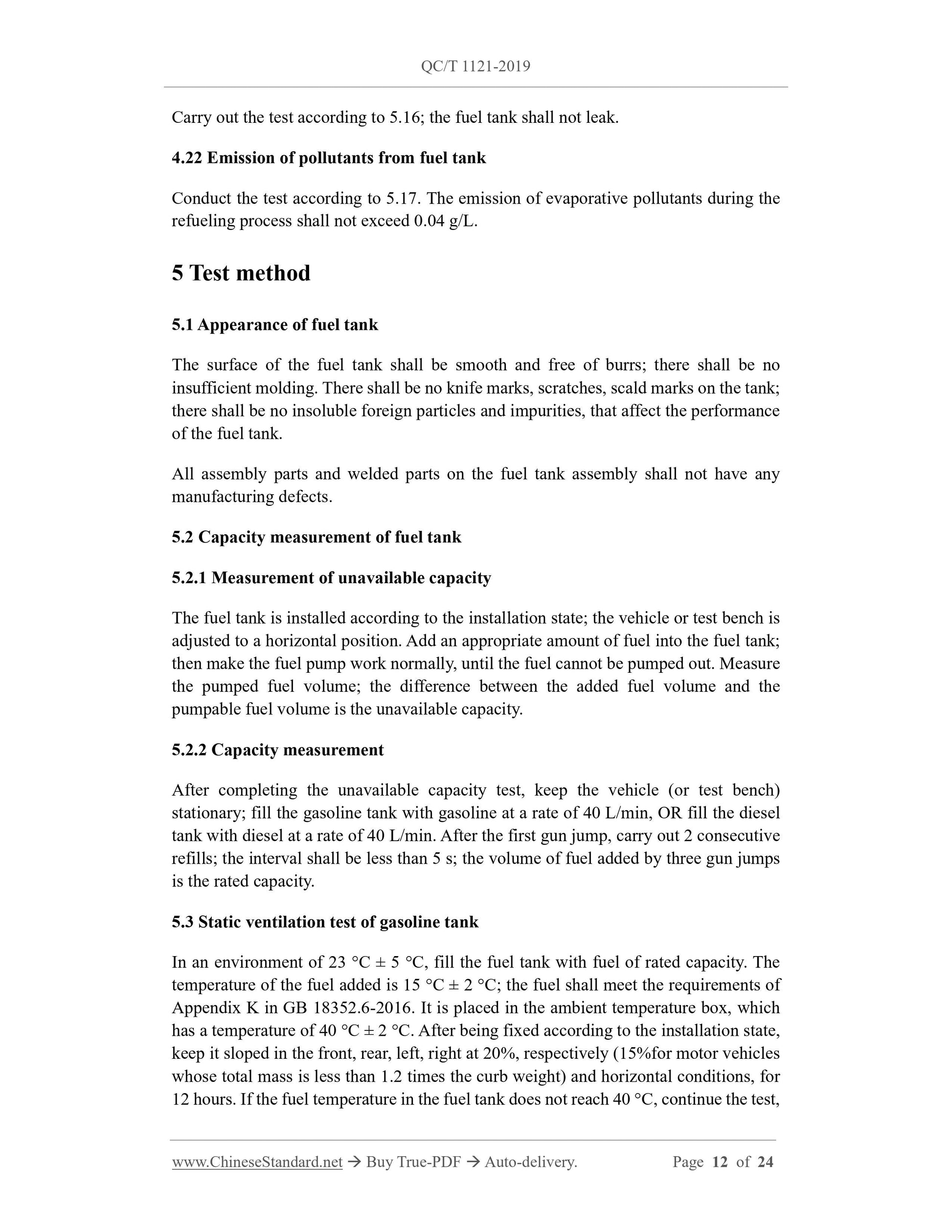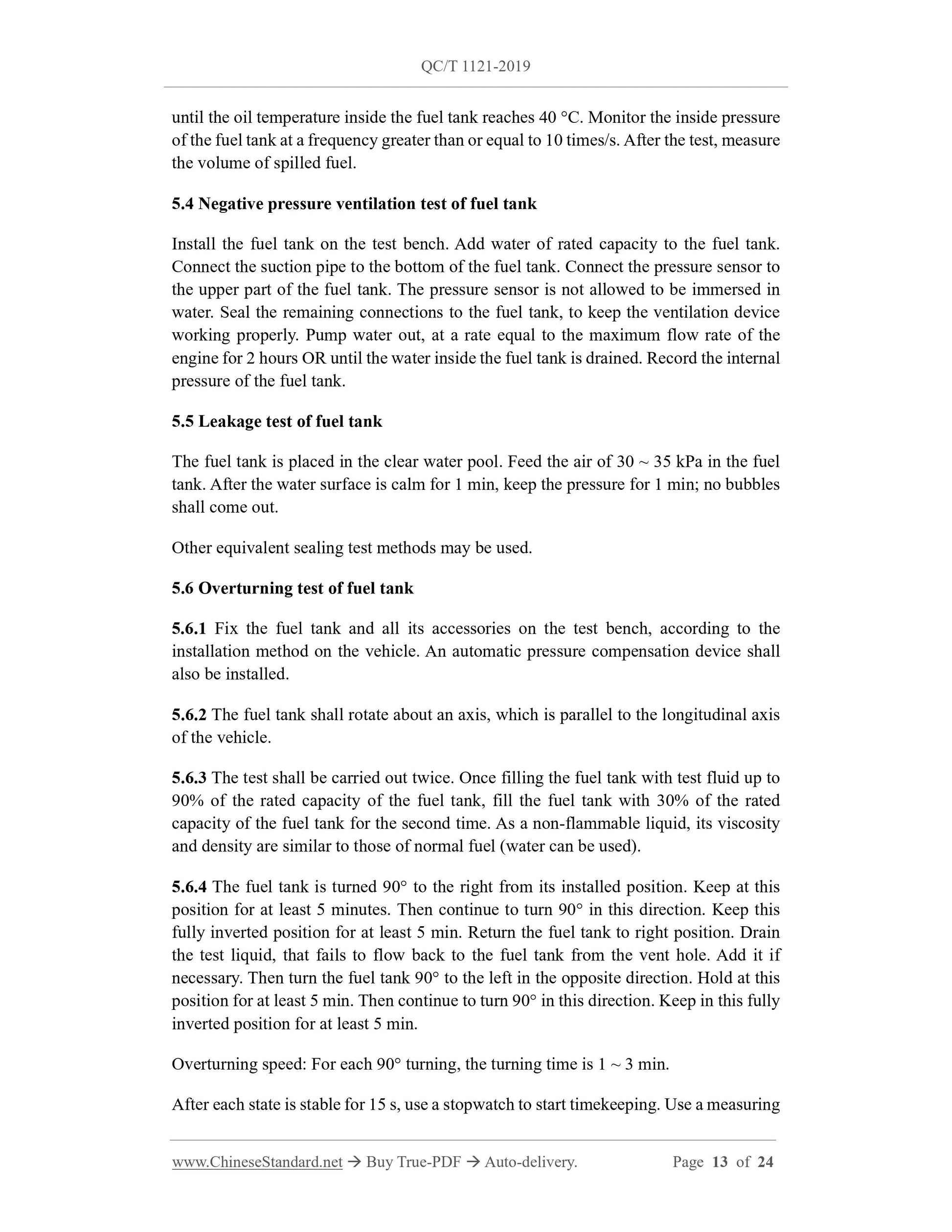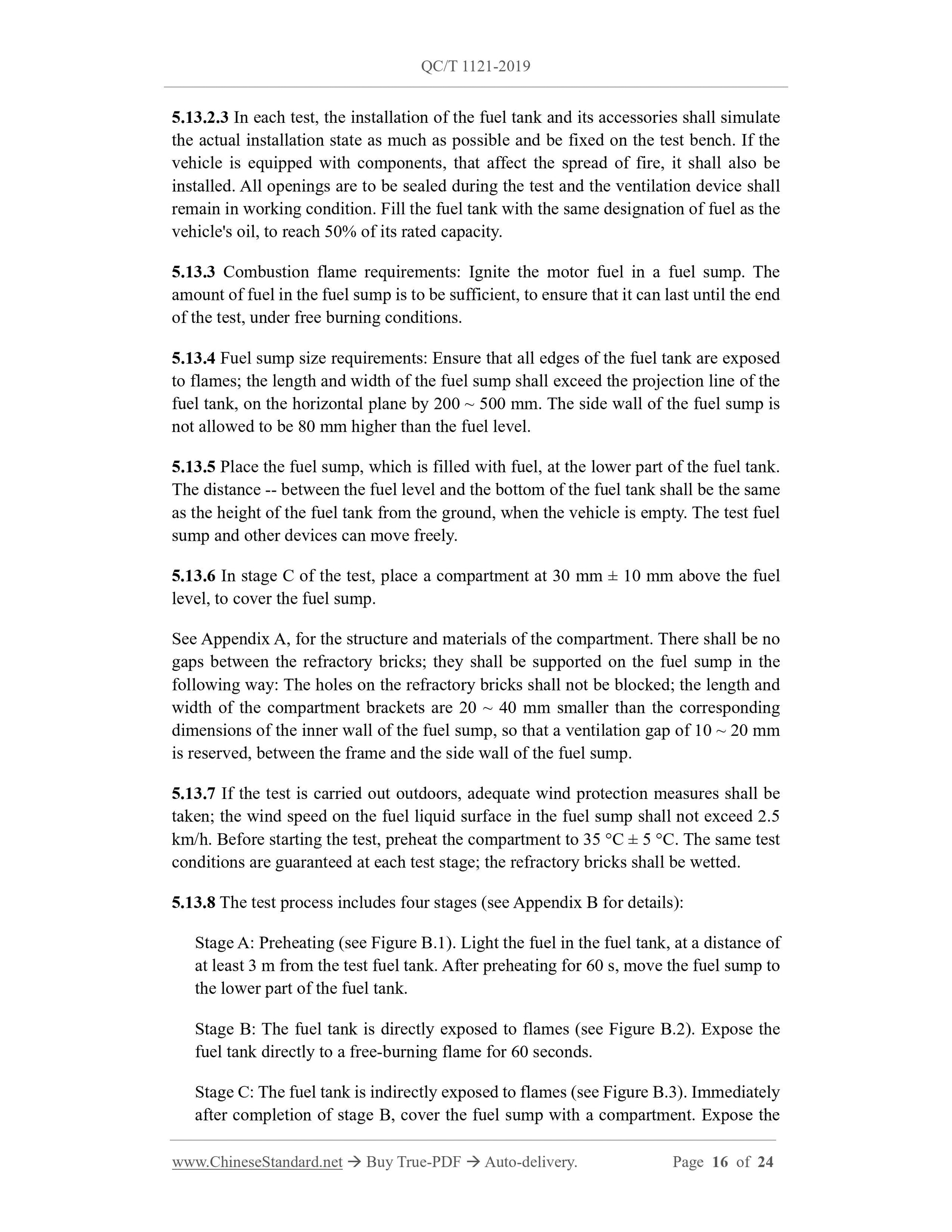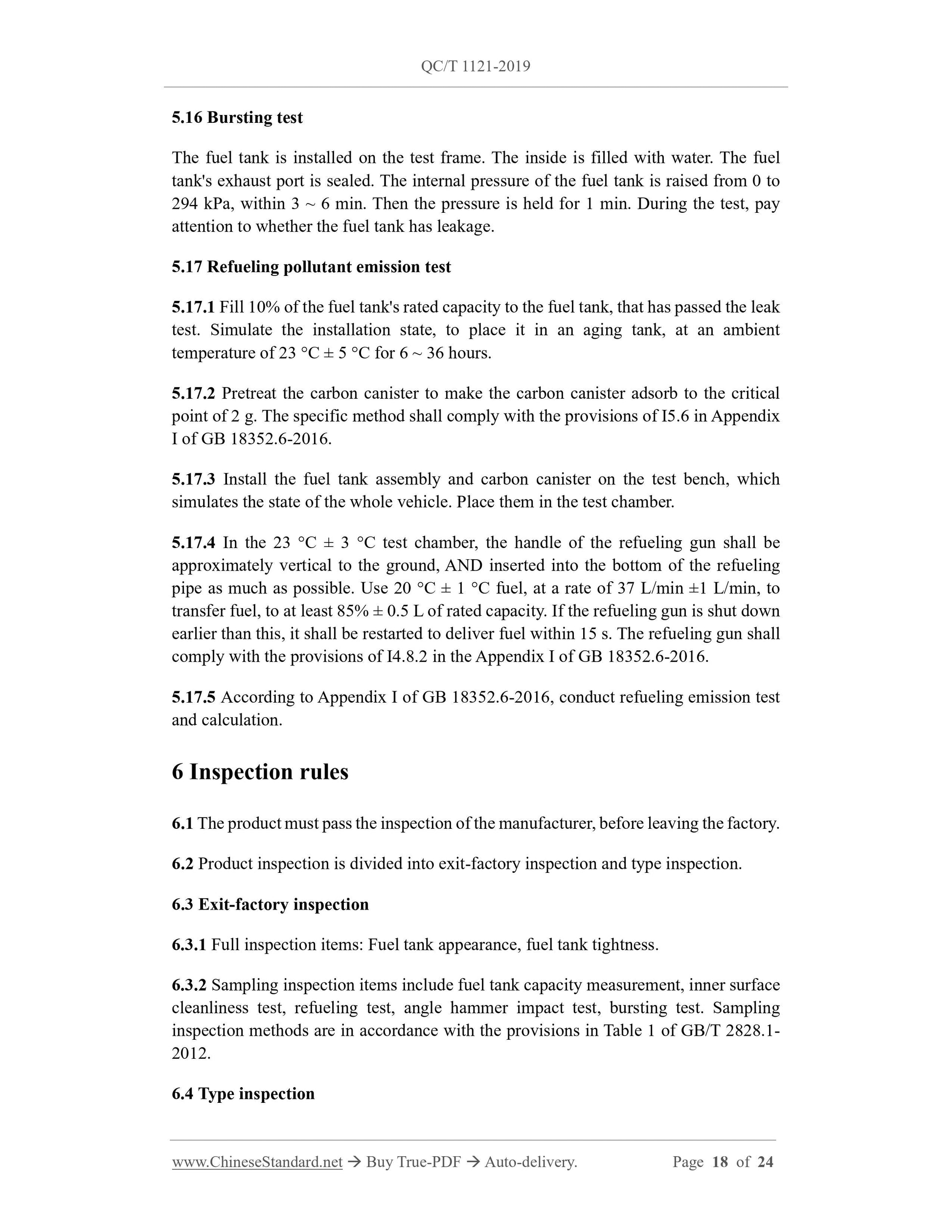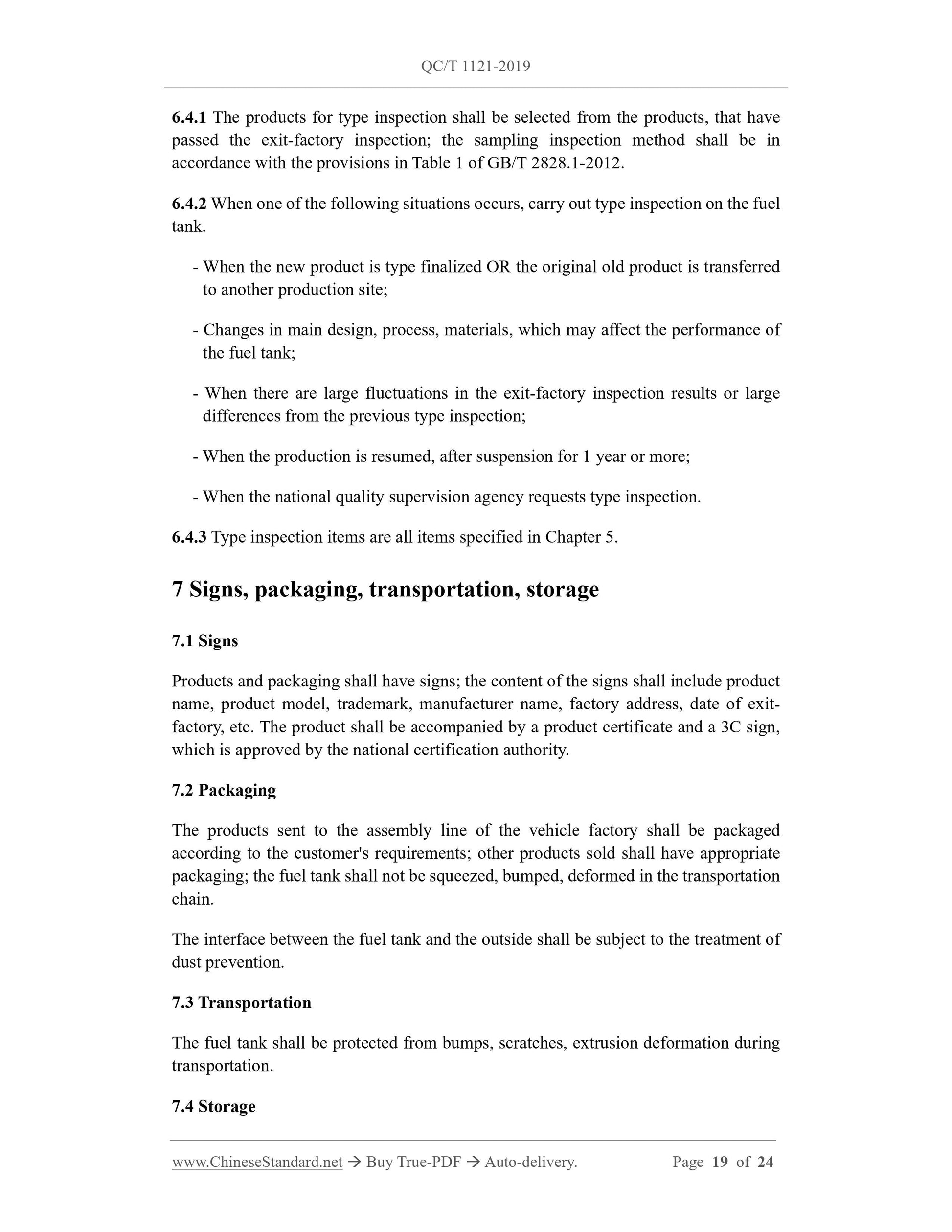1
/
of
10
PayPal, credit cards. Download editable-PDF & invoice in 1 second!
QC/T 1121-2019 English PDF (QCT1121-2019)
QC/T 1121-2019 English PDF (QCT1121-2019)
Regular price
$295.00 USD
Regular price
Sale price
$295.00 USD
Unit price
/
per
Shipping calculated at checkout.
Couldn't load pickup availability
Delivery: 3 seconds. Download true-PDF + Invoice.
Get QUOTATION in 1-minute: Click QC/T 1121-2019
Historical versions: QC/T 1121-2019
Preview True-PDF (Reload/Scroll if blank)
QC/T 1121-2019: Plastic fuel tank for vehicle
QC/T 1121-2019
QC
AUTOMOBILE INDUSTRY STANDARD
OF THE PEOPLE’S REPUBLIC OF CHINA
ICS 43.040.10
T 36
Plastic fuel tank for vehicle
ISSUED ON: NOVEMBER 11, 2019
IMPLEMENTED ON: APRIL 01, 2020
Issued by: Ministry of Industry and Information Technology of PRC
Table of Contents
Foreword ... 7
1 Scope ... 8
2 Normative references ... 8
3 Terms and definitions ... 8
4 Technical requirements ... 9
5 Test method ... 12
6 Inspection rules ... 18
7 Signs, packaging, transportation, storage ... 19
Appendix A (Normative) Refractory brick size and technical requirements ... 21
Appendix B (Normative) Fire resistance test ... 22
Appendix C (Normative) Vacuum pressure alternating curve ... 24
Plastic fuel tank for vehicle
1 Scope
This standard specifies the performance requirements and test methods for plastic fuel
tank for vehicle.
This standard is applicable to the plastic fuel tanks of categories M and N vehicles. The
plastic fuel tanks of other vehicles can be implemented with reference to this standard.
2 Normative references
The following documents are essential to the application of this document. For the dated
documents, only the versions with the dates indicated are applicable to this document;
for the undated documents, only the latest version (including all the amendments) is
applicable to this standard.
GB 18296 Safety property requirements and test methods for automobile fuel tank
and its installation
GB 18352.6-2016 Limits and measurement methods for emissions from light-duty
vehicles (CHINA 6)
3 Terms and definitions
The terms and definitions, as defined in GB 18296 and GB 18352.6-2016, as well as
the following terms and definitions, apply to this standard.
3.1
Plastic fuel tank
An independent tank assembly that is assembled from the plastic fuel tank, fuel filler
pipe, fuel filler inlet, fuel tank cap, pipe joints and other accessories AND fixed on
the vehicle for storing fuel (hereinafter referred to as the fuel tank).
3.2
Unusable volume
The volume of the fuel tank, which is occupied by the fuel that cannot be sucked out
by the fuel supply device.
3.3
Vehicle of category I
Category M1 vehicles, which have no more than six seats including the driver's seat
AND a maximum design gross mass of no more than 2500 kg.
4 Technical requirements
4.1 General requirements
The fuel tank shall comply with the provisions of this standard. It shall be manufactured
according to the drawings and technical documents, which are approved by the
prescribed procedures.
If the user has other special requirements, it shall be negotiated between the
manufacturer and the user; corresponding provisions shall be made in the product
drawings and related design documents.
4.2 Appearance of fuel tank
The appearance of the fuel tank is inspected visually.
4.3 Fuel tank material
4.3.1 The material of the fuel tank shall be resistant to fuel for vehicles.
4.3.2 Fuel tanks are made of high temperature and low temperature resistant materials.
4.4 Fuel tank capacity
It shall be tested according to 5.2; the capacity tolerance is ±3% of the rated capacity.
4.5 Automatic pressure compensation device of fuel tank
The fuel tank shall have an automatic pressure compensation device, which can
automatically compensate the working pressure or safety pressure of the fuel tank, such
as vent valve, safety valve, etc.
4.6 Requirements for preventing loss of fuel tank cap
The fuel tank cap shall be fixed onto the filler pipe. In the event of a missing fuel tank
cap, this requirement is considered to be complied with, if there are means to prevent
excessive evaporation of fuel and fuel spillage. Specifically, the following methods can
be used:
a) A non-removable fuel tank cap, that opens and closes automatically.
b) Any other measure having the same effect, for example (including but not limited
to), pull-strap fuel tank cap, chain-type fuel tank cap, etc., OR a fuel tank cap that
uses the same key as the ignition key (in this case, only when the fuel tank cap is
locked, can the key be pulled out of the fuel tank cap). But for other vehicles than
the categories M1 and N1 vehicles, it is not enough to only use the pull-strap type
fuel tank cap or chain type fuel tank cap as a measure.
4.7 Anti-static requirements for fuel tanks
The design and installation of the fuel tank and its accessories shall avoid any fire,
which is caused by static electricity. For fuel tanks containing fuel with a flash point
below 55 °C, it shall take necessary discharge measures.
4.8 Fuel tank ventilation performance
4.8.1 Static ventilation performance of the gasoline tank: Simulate the slope and level
conditions of the gasoline vehicle in the front, rear, left, right slopes of 20% (15% for
motor vehicles, whose total mass is less than 1.2 times the curb weight), to carry out
test according to 5.3. The pressure difference -- between the inside and outside of the
gasoline tank -- shall be less than or equal to 10 kPa; meanwhile, there shall be no liquid
fuel overflowing into the carbon tank.
4.8.2 Negative pressure ventilation performance of the fuel tank: The outside air shall
be able to flow into the fuel tank, through the ventilation device. The test shall be carried
out, according to 5.4. The pressure difference -- between the inside and outside of the
fuel tank -- shall be greater than or equal to -2.5 kPa.
4.9 Fuel tank tightness
Carry out the test according to 5.5. There shall be no air bubbles.
4.10 Fuel tank over-turnability
During normal use of the vehicle, the fuel shall not overflow from the fuel tank cap, nor
shall it overflow from the automatic pressure compensation device. When the
overturning test is carried out according to 5.6, fuel leakage is allowed; however, the
leakage rate shall not exceed 30 g/min. The gasoline fuel tank cap is not allowed to
have fuel leakage.
4.11 Cleanliness of the inner surface of fuel tank
The test shall be carried out in accordance with 5.7. The insoluble solid impurities inside
the fuel tank shall be less than or equal to 0.04 g.
4.12 Refueling performance
The test shall be carried out in accordance with 5.8. The fueling volume for the first
Carry out the test according to 5.16; the fuel tank shall not leak.
4.22 Emission of pollutants from fuel tank
Conduct the test according to 5.17. The emission of evaporative pollutants during the
refueling process shall not exceed 0.04 g/L.
5 Test method
5.1 Appearance of fuel tank
The surface of the fuel tank shall be smooth and free of burrs; there shall be no
insufficient molding. There shall be no knife marks, scratches, scald marks on the tank;
there shall be no insoluble foreign particles and impurities, that affect the performance
of the fuel tank.
All assembly parts and welded parts on the fuel tank assembly shall not have any
manufacturing defects.
5.2 Capacity measurement of fuel tank
5.2.1 Measurement of unavailable capacity
The fuel tank is installed according to the installation state; the vehicle or test bench is
adjusted to a horizontal position. Add an appropriate amount of fuel into the fuel tank;
then make the fuel pump work normally, until the fuel cannot be pumped out. Measure
the pumped fuel volume; the difference between the added fuel volume and the
pumpable fuel volume is the unavailable capacity.
5.2.2 Capacity measurement
After completing the unavailable capacity te...
Get QUOTATION in 1-minute: Click QC/T 1121-2019
Historical versions: QC/T 1121-2019
Preview True-PDF (Reload/Scroll if blank)
QC/T 1121-2019: Plastic fuel tank for vehicle
QC/T 1121-2019
QC
AUTOMOBILE INDUSTRY STANDARD
OF THE PEOPLE’S REPUBLIC OF CHINA
ICS 43.040.10
T 36
Plastic fuel tank for vehicle
ISSUED ON: NOVEMBER 11, 2019
IMPLEMENTED ON: APRIL 01, 2020
Issued by: Ministry of Industry and Information Technology of PRC
Table of Contents
Foreword ... 7
1 Scope ... 8
2 Normative references ... 8
3 Terms and definitions ... 8
4 Technical requirements ... 9
5 Test method ... 12
6 Inspection rules ... 18
7 Signs, packaging, transportation, storage ... 19
Appendix A (Normative) Refractory brick size and technical requirements ... 21
Appendix B (Normative) Fire resistance test ... 22
Appendix C (Normative) Vacuum pressure alternating curve ... 24
Plastic fuel tank for vehicle
1 Scope
This standard specifies the performance requirements and test methods for plastic fuel
tank for vehicle.
This standard is applicable to the plastic fuel tanks of categories M and N vehicles. The
plastic fuel tanks of other vehicles can be implemented with reference to this standard.
2 Normative references
The following documents are essential to the application of this document. For the dated
documents, only the versions with the dates indicated are applicable to this document;
for the undated documents, only the latest version (including all the amendments) is
applicable to this standard.
GB 18296 Safety property requirements and test methods for automobile fuel tank
and its installation
GB 18352.6-2016 Limits and measurement methods for emissions from light-duty
vehicles (CHINA 6)
3 Terms and definitions
The terms and definitions, as defined in GB 18296 and GB 18352.6-2016, as well as
the following terms and definitions, apply to this standard.
3.1
Plastic fuel tank
An independent tank assembly that is assembled from the plastic fuel tank, fuel filler
pipe, fuel filler inlet, fuel tank cap, pipe joints and other accessories AND fixed on
the vehicle for storing fuel (hereinafter referred to as the fuel tank).
3.2
Unusable volume
The volume of the fuel tank, which is occupied by the fuel that cannot be sucked out
by the fuel supply device.
3.3
Vehicle of category I
Category M1 vehicles, which have no more than six seats including the driver's seat
AND a maximum design gross mass of no more than 2500 kg.
4 Technical requirements
4.1 General requirements
The fuel tank shall comply with the provisions of this standard. It shall be manufactured
according to the drawings and technical documents, which are approved by the
prescribed procedures.
If the user has other special requirements, it shall be negotiated between the
manufacturer and the user; corresponding provisions shall be made in the product
drawings and related design documents.
4.2 Appearance of fuel tank
The appearance of the fuel tank is inspected visually.
4.3 Fuel tank material
4.3.1 The material of the fuel tank shall be resistant to fuel for vehicles.
4.3.2 Fuel tanks are made of high temperature and low temperature resistant materials.
4.4 Fuel tank capacity
It shall be tested according to 5.2; the capacity tolerance is ±3% of the rated capacity.
4.5 Automatic pressure compensation device of fuel tank
The fuel tank shall have an automatic pressure compensation device, which can
automatically compensate the working pressure or safety pressure of the fuel tank, such
as vent valve, safety valve, etc.
4.6 Requirements for preventing loss of fuel tank cap
The fuel tank cap shall be fixed onto the filler pipe. In the event of a missing fuel tank
cap, this requirement is considered to be complied with, if there are means to prevent
excessive evaporation of fuel and fuel spillage. Specifically, the following methods can
be used:
a) A non-removable fuel tank cap, that opens and closes automatically.
b) Any other measure having the same effect, for example (including but not limited
to), pull-strap fuel tank cap, chain-type fuel tank cap, etc., OR a fuel tank cap that
uses the same key as the ignition key (in this case, only when the fuel tank cap is
locked, can the key be pulled out of the fuel tank cap). But for other vehicles than
the categories M1 and N1 vehicles, it is not enough to only use the pull-strap type
fuel tank cap or chain type fuel tank cap as a measure.
4.7 Anti-static requirements for fuel tanks
The design and installation of the fuel tank and its accessories shall avoid any fire,
which is caused by static electricity. For fuel tanks containing fuel with a flash point
below 55 °C, it shall take necessary discharge measures.
4.8 Fuel tank ventilation performance
4.8.1 Static ventilation performance of the gasoline tank: Simulate the slope and level
conditions of the gasoline vehicle in the front, rear, left, right slopes of 20% (15% for
motor vehicles, whose total mass is less than 1.2 times the curb weight), to carry out
test according to 5.3. The pressure difference -- between the inside and outside of the
gasoline tank -- shall be less than or equal to 10 kPa; meanwhile, there shall be no liquid
fuel overflowing into the carbon tank.
4.8.2 Negative pressure ventilation performance of the fuel tank: The outside air shall
be able to flow into the fuel tank, through the ventilation device. The test shall be carried
out, according to 5.4. The pressure difference -- between the inside and outside of the
fuel tank -- shall be greater than or equal to -2.5 kPa.
4.9 Fuel tank tightness
Carry out the test according to 5.5. There shall be no air bubbles.
4.10 Fuel tank over-turnability
During normal use of the vehicle, the fuel shall not overflow from the fuel tank cap, nor
shall it overflow from the automatic pressure compensation device. When the
overturning test is carried out according to 5.6, fuel leakage is allowed; however, the
leakage rate shall not exceed 30 g/min. The gasoline fuel tank cap is not allowed to
have fuel leakage.
4.11 Cleanliness of the inner surface of fuel tank
The test shall be carried out in accordance with 5.7. The insoluble solid impurities inside
the fuel tank shall be less than or equal to 0.04 g.
4.12 Refueling performance
The test shall be carried out in accordance with 5.8. The fueling volume for the first
Carry out the test according to 5.16; the fuel tank shall not leak.
4.22 Emission of pollutants from fuel tank
Conduct the test according to 5.17. The emission of evaporative pollutants during the
refueling process shall not exceed 0.04 g/L.
5 Test method
5.1 Appearance of fuel tank
The surface of the fuel tank shall be smooth and free of burrs; there shall be no
insufficient molding. There shall be no knife marks, scratches, scald marks on the tank;
there shall be no insoluble foreign particles and impurities, that affect the performance
of the fuel tank.
All assembly parts and welded parts on the fuel tank assembly shall not have any
manufacturing defects.
5.2 Capacity measurement of fuel tank
5.2.1 Measurement of unavailable capacity
The fuel tank is installed according to the installation state; the vehicle or test bench is
adjusted to a horizontal position. Add an appropriate amount of fuel into the fuel tank;
then make the fuel pump work normally, until the fuel cannot be pumped out. Measure
the pumped fuel volume; the difference between the added fuel volume and the
pumpable fuel volume is the unavailable capacity.
5.2.2 Capacity measurement
After completing the unavailable capacity te...
Share
